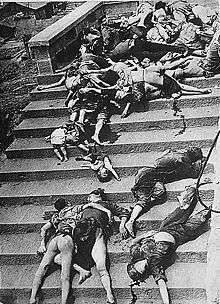Bombing of Chongqing
| ||||||||||||||||||||||||||||
The bombing of Chongqing (simplified Chinese: 重庆大轰炸; traditional Chinese: 重慶大轟炸, Japanese: 重慶爆撃, from 18 February 1938 to 23 August 1943) was part of a terror bombing operation conducted by the Imperial Japanese Army Air Service and Imperial Japanese Navy Air Service on the Chinese provisional capital of Chongqing, authorized by the Imperial General Headquarters.
A total of 268 air raids were conducted against Chongqing, with more than 11,500, mainly incendiary, bombs dropped. The targets were usually residential areas, business areas, schools, hospitals and other non-military targets. These bombings were probably aimed at cowing the Chinese government, or as part of the planned Sichuan invasion.
The raids

In the first two days of the campaign, the raids of May 1939 killed more than five thousand Chinese civilians.[1]
Two months later, after tens of thousands of deaths, in retaliation for firebombing, the United States embargoed the export of airplane parts to Japan, thus imposing its first economic sanction against that nation.[1]
On 5 June 1941, the Japanese flew more than 20 sorties, bombing the city for three hours. About 4,000 residents who hid in a tunnel were asphyxiated.[2]
The majority of the air raids conducted against Chongqing were made with squadrons of Mitsubishi G3Ms, known as "Nells", Mitsubishi Ki-1-Is, Fiat BR.20 Cicognas ("Ruths"), Mitsubishi Ki-21s "Sallys" and Kawasaki Ki-48s "Lilys" although towards the end of the Second Sino-Japanese War, Mitsubishi G4Ms ("Bettys"), Nakajima Ki-49 Donryus ("Helens"), Yokosuka P1Y Gingas ("Frances") and Mitsubishi Ki-67 Hiryus ("Peggys") were also employed. Due to severe attrition of aircraft and veteran pilots of the Chinese Air Force initially equipped at the outbreak of the air war in 1937 with largely US-made aircraft and training (and training with Italian air force instructors), the Chinese Air Force increasingly relied on Soviet Union's assistance during the retreat and defense of Wuhan in 1938 and further retreat and defense of Chungking in 1939-41; Chinese pilots flying primarily the Polikarpov I-16 and I-15 series of fighter-pursuit aircraft in defense of Chongqing and Chengdu.[3][4]
Following the Japanese attack on Pearl Harbor in December 1941, the United States declared war on Japan, reinvigorating support for China against Japanese imperialist aggressions, and an immediate Sino-US cooperation with planning of the Doolittle Raid against Japan in April 1942.[5] By August 1943, modern interceptor aircraft possessing greater speed and firepower, ground-based radar equipment, and better aircrew training supplied by the US and other Allied nations left the ROCAF in a much better position to fight back and, along with the diversion of Japanese aerial assets in support of the war in the Pacific, helped curtail further Japanese bombing sorties. The last recorded air raid of the campaign took place on 19 December 1944.
Total bomb tonnage and raids
Three-thousand tons of bombs were dropped on the city between 1939 and 1942.[2] According to photographer Carl Mydans, the spring 1941 bombings were "the most destructive shelling ever made on a city",[6] although by comparison 2,300 tons of bombs were dropped by Allied bombers on Berlin in a single night during the Battle of Berlin.[7] A total of 268 air raids were conducted against Chongqing.
Lawsuit against the Japanese government
In March 2006, 40 Chinese who were wounded or lost family members during the bombings sued the Japanese government demanding 10,000,000 yen (628,973 yuan) each and asked for apologies. "By filing a lawsuit, we want the Japanese people to know about Chongqing bombings," said a victim.[8][9]
Gallery
-

Volunteer army leaving Chongqing

References
- 1 2 Herbert Bix (2001). Hirohito and the Making of Modern Japan., p.364
- 1 2 Don Moser (1978). China-Burma-India. Time-Life., pp.11, 8
- ↑ surfcity.kund.dalnet.se/sino-japanese-1939.htm
- ↑ http://www.warbirdforum.com/cafhist3.htm
- ↑ http://www.historynet.com/payback-for-pearl.htm
- ↑ Don Moser, China-Burma-India, Time-Life, 1978, p.8
- ↑ "World War 2 Timelines".
- ↑ "Chongqing bombing victims sue". Japan Times. 31 March 2006. Retrieved 3 January 2013.
- ↑ "Japanese Government accused of Chongqing Bombings". People's Daily Online. Retrieved 3 January 2013.
External links
- Memorial site
- "Bombing of Chongqing", Nippon News, No. 2. in the official website of NHK.
